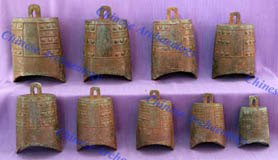Tomb No.1 of the Spring-and-Autumn at Shuangdun, Bangbu City, Anhui Province
The tomb in question is located at the Shuangdun Village, 3km to the north of the Huai River, within the Bangbu City, Anhui Province. From December of 2006 to August of 2008, the Anhui Provincial Institute of Cultural Heritage and Archaeology and the Bangbu Museum carried out a rescue excavation of the tomb.


The tomb has a mound sitting upon a layer of whitish clay. Both the mound and the filling in the tomb pit are five-colored mixed earth. The tomb pit is a circular shaft pit of 20.2m wide at mouth and 7.5m deep; it has a ledge built of virgin soil at the bottom and a short stepped ramp at the eastern side. 0.7m below the ground there is a formation twenty radiating bands made of earth of five colors. At the depth of 0.7-1.4m there are eighteen cone-like formations around the tomb walls; at the same depth are also found over 1000 unbaked clay “figurines” of the conical or square shape. At the ledge three or four layers of “clay figurines” constituted walls at some distance from the tomb walls; the clay figurine walls further climb up the stepped ramp. The bottom of the tomb is in the shape of cruciform. Around the chamber, there are three sacrificed human victims at the eastern, western, and northern sides, and one at the southern side and a large side chamber composed of two boxes.


The wooden chamber and coffin are both rotten; and the sacrificial victims each have their own coffins. The human remains are not well preserved, but the main occupant is about 40 years old, and the sacrificial victims are mostly 20-30 years. The accompanying goods are mostly placed in the boxes in the side chamber; a few are placed in the main coffin and side coffins. There is a special box for containing the three sacrificial animals. The accompanying goods are rich and consist of chime bells, ding-tripod, lei-urn, pu-jar, he-pitcher, ye-pourer, pan, yan-steamer, dou-tureen, weapons, and chariot fittings made of bronze, painted pottery wares, hard wares imprinted with geometric patterns, many rotten lacquerwares, and a group of dragon-headed stone qing-instruments, and various jades. Most bronze vessels bear the inscription of “Tongli Jun Bai童麗君柏”, which identifies the occupant as the “Lord Bai 柏 of Zhongli钟离”. “Zhongli” is a kingdom in the middle Huai River Valley occasionally appearing in the received documents. The typology of the accompanying goods ascribes the tomb to the middle or late Spring- and-Autumn Period.

The tomb is a very important discovery. Because of its discovery, the Zhongli kingdom is proven to have existed in the middle Huai River Valley. It thus throws light into the history of the Zhongli Kingdom and the king list of this polity as well as the local cultures of the Huai Barbarians.
Translated by Zhang Liangren

